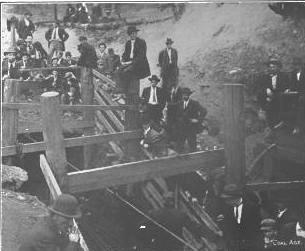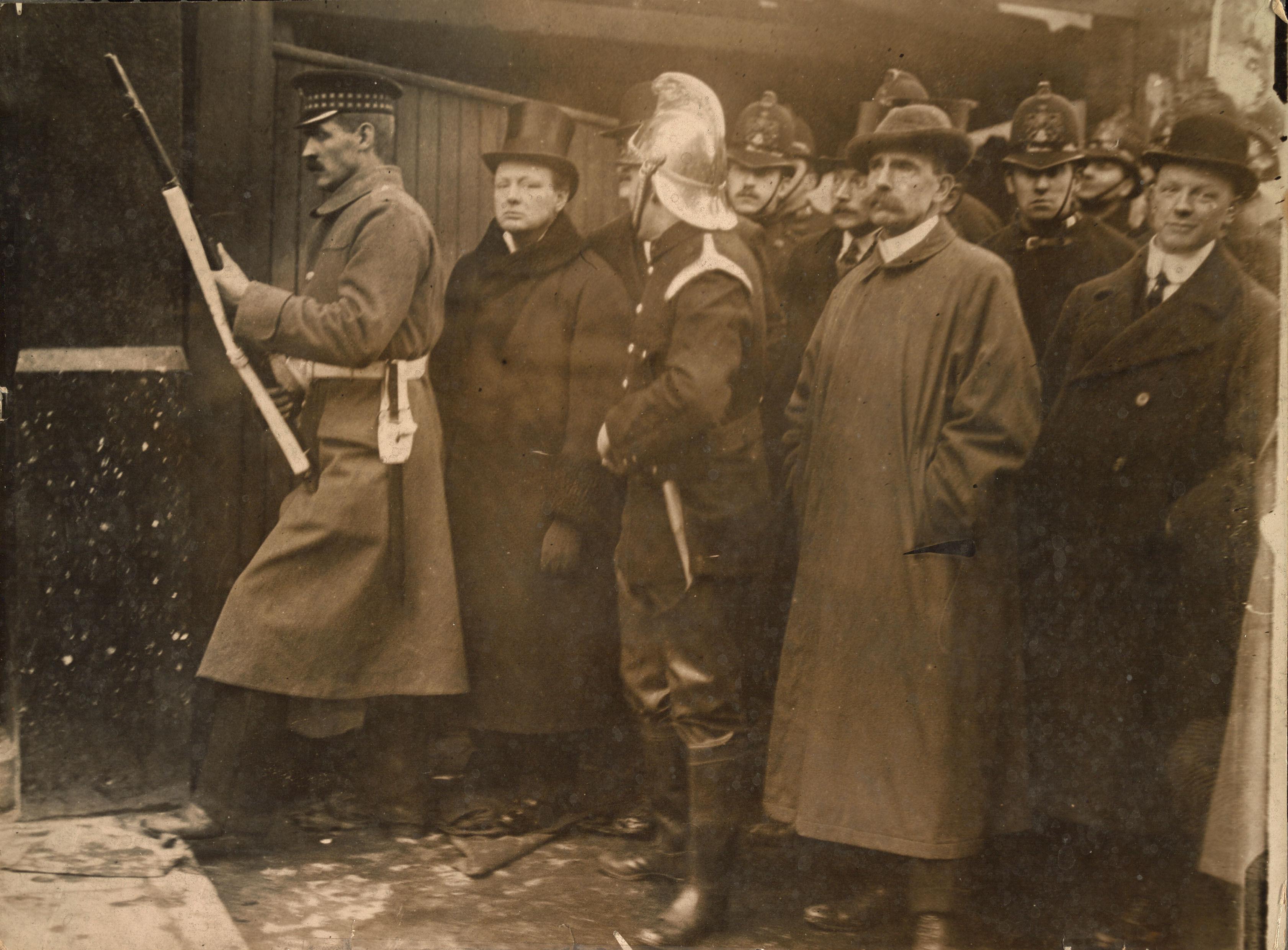|
Cross Mountain Mine Disaster
The Cross Mountain Mine disaster was a coal mine explosion that occurred on December 9, 1911, near the community of Briceville, Tennessee, in the southeastern United States. In spite of a well-organized rescue effort led by the newly created Bureau of Mines, 84 miners died as a result of the explosion. The likely cause of the explosion was the ignition of dust and gas released by a roof fall. At least 22 of the miners killed in the Cross Mountain Mine disaster were buried in a circular memorial known as the Cross Mountain Miners' Circle, which is now listed on the National Register of Historic Places. Geographical setting Cross Mountain is a massive ridge situated along the eastern Cumberland Plateau just west of the plateau's Walden Ridge escarpment, in the coal-rich Cumberland Mountains. Rising to an elevation of , the mountain is the highest point in Tennessee west of the Blue Ridge Province. The mountain is located along the border between Anderson County and Ca ... [...More Info...] [...Related Items...] OR: [Wikipedia] [Google] [Baidu] |
Briceville, Tennessee
Briceville is an unincorporated community in Anderson County, Tennessee, United States. It is included in the Knoxville, Tennessee Metropolitan Statistical Area. The community is named for railroad tycoon and one-term Democratic U.S. Senator Calvin S. Brice of Ohio, who was instrumental in bringing railroad service to the town.Amanda Post and Emily Robinson, National Register of Historic Places Nomination Form for Briceville Community Church and Cemetery, October 2002. The Briceville zip code, 37710, which also includes a large remote mountain area west of the community formerly served by the now-closed Devonia post office, had a population of 1,441 as of the 2000 U.S. Census.U.S. Department of Commerce, Bureau of the Census,Zip Tabulation Area 37710 Fact Sheet." Retrieved: 15 February 2010. Briceville's economy was historically based on coal mining. Briceville played an important role in three major late-19th and early-20th century incidents related to the region's coal m ... [...More Info...] [...Related Items...] OR: [Wikipedia] [Google] [Baidu] |
National Register Of Historic Places In Anderson County, Tennessee
__NOTOC__ This is a list of the National Register of Historic Places listings in Anderson County, Tennessee. This is intended to be a complete list of the properties and districts on the National Register of Historic Places in Anderson County, Tennessee, United States. Latitude and longitude coordinates are provided for many National Register properties and districts; these locations may be seen together in a map. There are 19 properties and districts in the county that are listed on the National Register, and one former listing. See also National Register of Historic Places listings in Roane County, Tennessee for additional properties in Oak Ridge and Oliver Springs, cities that span the county line. Current listings Former listings See also *List of National Historic Landmarks in Tennessee *National Register of Historic Places listings in Tennessee References {{Anderson County, Tennessee Anderson Anderson or Andersson may refer to: Co ... [...More Info...] [...Related Items...] OR: [Wikipedia] [Google] [Baidu] |
1911 In Tennessee
A notable ongoing event was the race for the South Pole. Events January * January 1 – A decade after federation, the Northern Territory and the Australian Capital Territory are added to the Commonwealth of Australia. * January 3 ** 1911 Kebin earthquake: An earthquake of 7.7 moment magnitude strikes near Almaty in Russian Turkestan, killing 450 or more people. ** Siege of Sidney Street in London: Two Latvian anarchists die, after a seven-hour siege against a combined police and military force. Home Secretary Winston Churchill arrives to oversee events. * January 5 – Egypt's Zamalek SC is founded as a general sports and Association football club by Belgian lawyer George Merzbach as Qasr El Nile Club. * January 14 – Roald Amundsen's South Pole expedition makes landfall, on the eastern edge of the Ross Ice Shelf. * January 18 – Eugene B. Ely lands on the deck of the USS ''Pennsylvania'' stationed in San Francisco harbor, the ... [...More Info...] [...Related Items...] OR: [Wikipedia] [Google] [Baidu] |
1911 Mining Disasters
A notable ongoing event was the race for the South Pole. Events January * January 1 – A decade after federation, the Northern Territory and the Australian Capital Territory are added to the Commonwealth of Australia. * January 3 ** 1911 Kebin earthquake: An earthquake of 7.7 moment magnitude strikes near Almaty in Russian Turkestan, killing 450 or more people. ** Siege of Sidney Street in London: Two Latvian anarchists die, after a seven-hour siege against a combined police and military force. Home Secretary Winston Churchill arrives to oversee events. * January 5 – Egypt's Zamalek SC is founded as a general sports and Association football club by Belgian lawyer George Merzbach as Qasr El Nile Club. * January 14 – Roald Amundsen's South Pole expedition makes landfall, on the eastern edge of the Ross Ice Shelf. * January 18 – Eugene B. Ely lands on the deck of the USS ''Pennsylvania'' stationed in San Francisco harbor, the ... [...More Info...] [...Related Items...] OR: [Wikipedia] [Google] [Baidu] |
Cemeteries On The National Register Of Historic Places In Tennessee
A cemetery, burial ground, gravesite or graveyard is a place where the remains of dead people are buried or otherwise interred. The word ''cemetery'' (from Greek , "sleeping place") implies that the land is specifically designated as a burial ground and originally applied to the Roman catacombs. The term ''graveyard'' is often used interchangeably with cemetery, but a graveyard primarily refers to a burial ground within a churchyard. The intact or cremated remains of people may be interred in a grave, commonly referred to as burial, or in a tomb, an "above-ground grave" (resembling a sarcophagus), a mausoleum, columbarium, niche, or other edifice. In Western cultures, funeral ceremonies are often observed in cemeteries. These ceremonies or rites of passage differ according to cultural practices and religious beliefs. Modern cemeteries often include crematoria, and some grounds previously used for both, continue as crematoria as a principal use long after the interment areas ... [...More Info...] [...Related Items...] OR: [Wikipedia] [Google] [Baidu] |
Coal Mining Disasters In Tennessee
Coal is a combustible black or brownish-black sedimentary rock, formed as rock strata called coal seams. Coal is mostly carbon with variable amounts of other elements, chiefly hydrogen, sulfur, oxygen, and nitrogen. Coal is formed when dead plant matter decays into peat and is converted into coal by the heat and pressure of deep burial over millions of years. Vast deposits of coal originate in former wetlands called coal forests that covered much of the Earth's tropical land areas during the late Carboniferous ( Pennsylvanian) and Permian times. Many significant coal deposits are younger than this and originate from the Mesozoic and Cenozoic eras. Coal is used primarily as a fuel. While coal has been known and used for thousands of years, its usage was limited until the Industrial Revolution. With the invention of the steam engine, coal consumption increased. In 2020, coal supplied about a quarter of the world's primary energy and over a third of its electricity. Some iron a ... [...More Info...] [...Related Items...] OR: [Wikipedia] [Google] [Baidu] |




